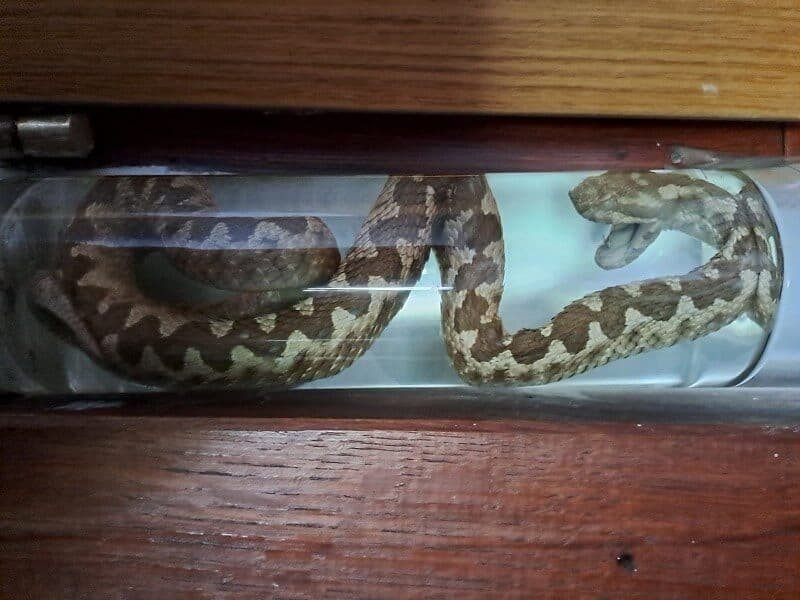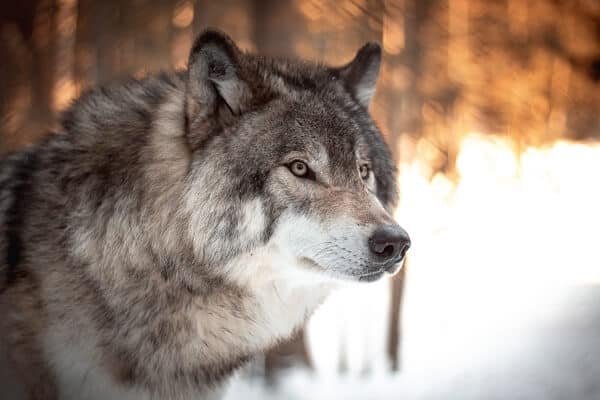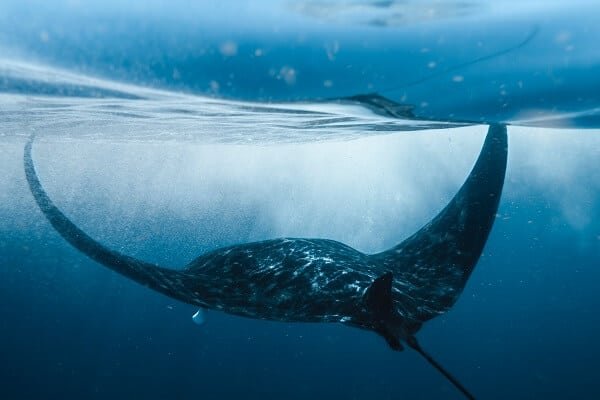Going to the beach, fishing, hiking, or sailing in Croatia is an exciting experience, but one should be aware of the dangerous animals in the Adriatic Sea and the forests.
Croatia isn’t particularly dangerous when it comes to animal encounters, yet to say there is nothing you should worry about would be a lie.
I am sure this article won’t be useful to Australians as they mastered survival already and the dangerous Croatian animals fear them. However, for the rest of you, please consider the following warnings for a safe and fun trip in Croatia.
I’ll start by mentioning a few continental animals first and then give you a whole list of dangerous animals of the Adriatic Sea.
Horned viper (Poskok)

Horned vipers are the true nemesis that populates the coastline area, with a high population around Velebit National Park, the region of Dalmatia, and Croatian islands besides some such as Cres.
Personally, horned vipers would always ruin my wish to explore the forests and rock formations during spring and summer months as I’d be afraid of their mere existence.
Horned vipers can be found near rocky beaches, so be careful not to accidentally bump into one!
Its poison is deadly if the bitten person doesn’t receive medical help within a few hours after the bite.
The horned viper can jump a meter above the ground before your reflexes trigger, so unless you are a cat, avoid any confrontation with this notorious snake.
If you hike in an area rich with horned vipers, wear hiking shoes, and long, thick pants and always check the suspicious area in front of you with a long stick before making a further step.
However, they are super rare to find if you follow the hiking trails, so there’s not much to worry about, it’s more of a psychological factor for some people.
Wild Boar (Divlja svinja)

Wild boars, the ancestors of farm pigs are a common danger in Croatian forests.
Wild boars are not only dangerous when encountered but they are invasive species as they can be found everywhere in Croatia.
Somehow they ended up on some Croatian islands such as Cres in recent years although it was never their habitat in the past.
The theory is they swam across the sea and found their new home in islands rich with vegetation.
Wild boars are a problem as they destroy everything in front of them and possess a danger to humans and pets, especially when a mother boar is accompanied by her piglets.
You may even encounter the wild boar roaming the streets in the superbia of cities as they often migrate from a forest to a forest in search of food.
If you encounter a wild boar stay away from it and hide, as it can weigh over 100 pounds, jump up to 5 feet in the air, run 25mps, and charge you with their dangerous husks.
While some are used to humans, some are the true psychos who will most often avoid confrontation, but if you get in their way they won’t hesitate to charge you.
Ticks (Krpelji)

If there’s one animal one should fear in Croatia, then that’s the ticks.
Tick-transmitted diseases that can have terrible consequences are:
- Lyme borreliosis
- Tick-borne meningoencephalitis
- Mediterranean spotted fever
None of these diseases are easy to take, and it’s possible that a tick you bump into carries one of these diseases.
While these diseases are treatable, complications aren’t uncommon and you want to avoid them at all costs.
Ticks usually live on the ground, particularly in shady areas and you can find them in the grass, bushes, and trees while walking through nature and even in gardens near homes.
To protect against ticks do the following:
- Wear long-sleeved shirts and long trousers tucked into socks
- Use tick repellent (HIGHLY RECOMMENDED)
- Avoid long grass and stick to footpaths
- Check yourself, or children, and your pets for ticks during and after spending time in nature
Black Widow (Crna udovica)

The black widow is the most poisonous spider in Europe and it thrives in the summer months.
You can find black widows in Istria, Dalmatia, Kvarner, and on islands from June to the early autumn.
These poisonous spiders are often found low near the ground, so leg bites are the most common danger when moving through the grass and fields in short pants.
Black Widow has strong neurotoxins and while its bite is painless and often unnoticed as the redness and itching could be misunderstood for a mosquito bite, already 10 minutes after the bite the stung person will experience pain in the regional lymphatic nodes and the pain will expand to the back, thighs, legs, and stomach.
The pain will then expand and become even stronger, and affected people might even experience difficulties with breathing and heartbeats due to increased blood pressure, nausea or vomiting, and even symptoms such as delirium and hallucinations.
I won’t continue as the experience isn’t nice by any meaning, but at least the good news is the mortality rate is super low as the poison isn’t fatal, but young children, the elderly population, and heart disease patients might experience complications.
Brown Bears (Medvjed)

There are around 1000 brown bears in Croatia, mostly populating Gorski Kotar and Lika with some percentage inhabiting the region of Dalmatia.
Brown bears in Croatia can be dangerous especially when a momma bear is approached around her cubs.
I believe you are already aware of how dangerous brown bears are and that any confrontation should be avoided.
However, I must assure you that incidents with brown bears are almost non-existent, as they usually avoid approaching humans and even the most experienced hikers with decades of experience only spot a bear a few times in their life.
As long as you stick to the hiking trails and don’t venture alone in the woods in the night and early morning hours, the chances of encountering a bear are extremely low.
Lynx (Ris)

According to the latest research, there are only around 60 lynxes in Croatia which explains why lynx encounters are so rare.
You can find Lynx in the area of Gorski Kotar if you are super fortunate and the area with the most lynxes is in National Park Risnjak.
After all, NP Risnjak got its name after the Croatian word for a lynx, ris.
Lynx are fabulous, beautiful, and shy animals who avoid confrontations, but will attack if cornered!
Their sharp claws and fangs accompanied by their swift and agile nature are enough to win most confrontations with the largest of dogs, so it’s good news they never pick fights.
Wolf (Vuk)

There are approximately around 200 wolves in Croatia and they are a protected species, so it’s illegal to hurt them.
Encounters with wolves in Croatia are rare, but they can happen from time to time.
There were stories of wolves attacking the stock and desperate farmers and shepherds couldn’t do much about it but pray the wolves would venture away back into the forest.
There’s no noticeable risk for hikers when it comes to wolf attacks, but stay on the trails and don’t hike during the night and early mornings as that’s when most animals get out to party.
Weevers fish (Riba pauk)

Weever fish is a danger you don’t see coming as they are buried in the shallow sand, and that’s exactly what’s scary about the weevers.
Weever is usually a small fish and while some units can get bigger than 30 centimeters, their venomous spikes are the real danger.
Stepping on a weever will cause it to burst out its venomous spikes which poison is capable of inflicting terrible pain and inflammation in the stung area.
While their poison isn’t generally deadly, some people with a particular allergy might fall into a shock and unless the necessary medical intervention is provided within the first couple of hours, the worst can happen.
Bear in mind that being allergic to weavers is rare, but you never know whether you are the unlucky one.
I talked to experienced fishermen about weevers, and heard stories of how the fishermen would occasionally get stung by the weever when they would pull out the fishing nets from the sea.
Nobody had complications with the sting, but they told me the pain was seriously bad and definitely worse than a sting from a wasp.
What they also told me is that the weevers are hard to step on as they move away when they feel the presence of humans, so there’s not much to worry about.
If this tickles your mind the next time you jump into the sea with sandy ground, wear sea shoes!
Red scorpionfish (Škarpina)

The red scorpionfish is the favorite ingredient of a good Croatian brudet, but to acquire its taste one must first defeat its venomous spike attacks.
This fish is less venomous than the weaver, yet its poison will still hurt badly and might cause complications in people with an allergic reaction.
Škarpina is a big (around 60 cm) redfish with a weird big head and spikes around the neck and on the back.
Škarpina rarely ever comes to the walkable area near the beaches so the odds of stepping on this fish are extremely rare.
However, it likes to hide in the sea ground and particularly between the rocks, so adventurous snorkels and divers should be aware not to touch it.
Sea urchins (Morski Jež)

Croatian sea urchins are the little nemesis that doesn’t possess particular danger as they are not poisonous, but their stings can hurt and ruin a day on a beach.
Many Croatian beaches are populated by sea urchins, and there’s a saying, “Sea urchins know where the sea is clear” which is often used in Croatia as proof of the quality of the seawater on a particular beach.
If you see a sea urchin (and they are easy to spot as they look like black meatballs with spikes) don’t touch them.
They can hardly move and there can be plenty of sea urchins in the area, so assume there are more if you only spot one.
Their sting hurts a little bit but it’s not that bad, however, sometimes their spike might break off and get stuck in the skin.
In such a case, removing the spike is important to avoid possible infections and further damage to the flesh, but further medicinal intervention is rarely required.
Sharks (Morski pas)

Sharks that inhabit the Adriatic Sea are not dangerous for humans, but there are stories of dangerous shark species such as the Great White that arrive by following the fish ships.
These instances are rare, and there are no dangers from shark attacks on the beaches.
As a matter of fact, the last time someone was attacked by a shark in Croatia was in 2008.
The most common shark that can be found in Croatia is the blue shark (Modrulj), which is a small shark not dangerous for humans.
My mother’s uncle is a professional diver who regularly swam with the blue sharks as they had a nest near Rijeka 50 years ago.
In his words, they were very friendly and cute.
Jellyfish (Meduza)

The Adriatic jellyfish can get really close to the beaches when the counters push them to the shore.
The worse of all is that they are always found in large numbers as they never travel solo, making the whole area repulsive to swimmers, divers, and snorkels during their visit.
Jellyfish is not good swimmer, so when the weather is unfavorable, they can remain in one area for days before they are finally gone as the counters change.
Jellyfish that can be found in Croatia aren’t dangerous for humans, but their sting can hurt and cause itching, so it’s definitely not a recommended experience.
Among the jellyfish species that inflict the most pain is Pelagia noctiluca detected in the southern Adriatic Sea and Chrysaora hysoscella detected in the northern Adriatic Sea.
In the last few years I haven’t seen nor heard of jellyfish encounters near Croatian beaches, but there had been such events in the past.
If you somehow get unlucky and jellyfishes ruin your favorite beach spot, just change the beach as there’s no absence of beautiful beaches in Croatia.
Eels (Jegulje)

Eel species such as Muraena helena are scary inhabitants of rocky and coral regions close to the shore.
While these eels lock straight out of horror movies, they are peaceful and hide in the holes within the rocks.
They won’t attack a diver, but if provoked they will bite and inflict serious damage with their sharp teeth.
Don’t touch the eels and you’ll be fine.
There are plenty of eels in the Adriatic Sea so encounter with one isn’t a rare occasion, and many fishermen hunt the eels as they are a delicious ingredient in a traditional Croatian brudet.
I noticed it’s the second or third time I am mentioning brudet, so check it out along with other tasty Croatian dishes!
Ray (Raža)

Devil rays and stingrays that inhibit the Adriatic Sea aren’t particularly dangerous and finding one in Croatia is a rare and lucky moment for ray lovers.
It’s important to stay away from a ray as their sting can cause annoying pain that can last hours and in some instances for days.
Truth be told, it’s really difficult to get stung by a ray as you need to get super close to them or step on them, and due to the fact that they aren’t typically seen anywhere on Croatian beaches, this is a very unrealistic scenario.
In conclusion, while rays of the Croatian Adriatic Sea aren’t life-threatening, they can inflict serious pain, so if you are lucky to find one respect it and get out of its way!
Fireworm (Morski crv)

Fireworm (lat. Hermodice carunculata) is a mean-looking inhabitant of rocky and algae-covered reefs in the Adriatic Sea.
This centipede-looking sea creature loves warm seas, and while it’s not easy to bump into it unless you dive around mentioned area, it can be a true nemesis.
When provoked, fireworms will raise their stinging bristles which can break upon contact and stick into the skin.
The poison found in these bristles can attack nerves at the affected spot and cause numbness and pain which can eventually cause dizziness and nausea.
In some cases even medical treatment is necessary, so if a person gets stung by the fireworm they should get out of the sea immediately and ask for help.
According to people who dive in the Adriatic Sea, fireworms can be found in the region of Dalmatia as that region of the Adriatic Sea is known for being particularly warm.
However, there are no dangers for swimmers and bystanders at Croatian beaches, as these worms are not found anywhere near the area populated by people.
Yet, if you are planning to dive into the depths (typically around 9 meters) near the fireworms, don’t touch them and you’ll be good as they are not the predators that will go after you.
Wait, what about scorpions?
Did I forget to mention the dangers of scorpions?
No, Croatian scorpions aren’t dangerous for humans nor for pets as their poison is weak and it’s difficult to get stung by one.
Common Croatian scorpions are Euroscorpius italicus and E. Germanus, neither one is dangerous, they like the humid, dark areas and can be found down the coastline under house mats, rags, and perhaps in working shoes that haven’t been used for a while.
Final take
The purpose of this article is to make you more conscious of certain dangers that come from the animals that inhibit Croatia.
If you were wondering if are there mosquitos in Croatia, there are and quite plenty, but they are not considered dangerous, just annoying.
While I included all technically dangerous animals that could hurt you in some way, most of the animals on the list aren’t a serious danger as they can easily be avoided or instances of confronting them are very rare.
However, I want to emphasize the importance of avoiding ticks, black widows, and horned vipers as these animals statistically display the greatest danger for visitors.
It’s good news there are no alligators and crocodiles in Croatia, and other insects such as scorpions aren’t dangerous as it’s the case in some other states.
Stay safe on your Croatian journey and don’t underestimate the power of nature!
